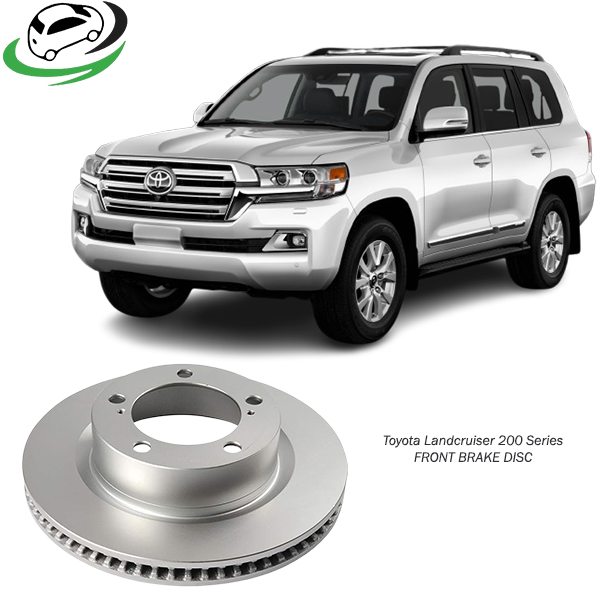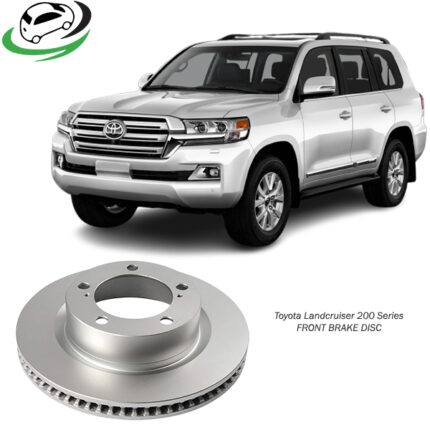Get Toyota Land Cruiser 200 Series Front Brake Disc 43512-60180
The front brake disc, also known as the front rotor, plays a crucial role in a vehicle’s braking system. As a core component of disc brakes, it is responsible for converting kinetic energy into thermal energy through friction. This process allows a vehicle to slow down or stop effectively. Front brake discs are particularly significant since they handle a majority of the braking load—often up to 70%. Understanding their design, functions, types, benefits, maintenance, and issues can help you make informed decisions regarding your vehicle’s braking system.
In this guide, we will explore the intricacies of front brake discs and how they contribute to safe and efficient braking.
Design and Components of Front Brake Discs
The front brake disc is a round, flat metal component mounted on the wheel hub. As the wheel rotates, the brake disc rotates with it. When the brake pedal is pressed, the brake pads clamp down on the disc, generating friction and slowing the vehicle.
Here are the key components of a front brake disc system:
- Brake Disc (Rotor):
- Made of cast iron or composites, the rotor is the part that the brake pads press against to create friction. Modern high-performance rotors may be made from carbon-ceramic or other advanced materials for better heat resistance.
- Brake Pads:
- These are flat, rectangular pieces made from high-friction materials such as ceramic, metallic, or organic compounds. Brake pads press against the disc’s surface to slow the vehicle.
- Brake Caliper:
- The caliper houses the brake pads and pistons. When the brake pedal is pressed, hydraulic pressure forces the caliper pistons to push the brake pads against the rotor.
- Hydraulic System:
- This system transmits the pressure from the brake pedal to the caliper via brake fluid. It allows the driver to apply minimal effort to control the brakes effectively.
- Wheel Hub:
- The brake disc is mounted on the wheel hub, ensuring that the rotor rotates with the wheel.
Functions of Front Brake Discs
Front brake discs are designed to handle intense friction and heat, playing a vital role in stopping the vehicle. Key functions include:
- Primary Braking Force:
- Since most of a vehicle’s weight shifts to the front during braking, the front brake discs are responsible for handling a larger portion of the braking force. This is why front discs are often larger and more robust than rear discs.
- Friction Generation:
- The core function of the brake disc is to provide a surface for the brake pads to generate friction. This friction converts kinetic energy (motion) into thermal energy (heat), slowing the vehicle.
- Heat Dissipation:
- Brake discs are designed to dissipate heat generated during braking. This is critical for preventing brake fade, where the system becomes less effective due to overheating. Vented, drilled, or slotted discs improve cooling.
- Stable Braking Performance:
- Front brake discs contribute to stable braking performance, helping the vehicle to slow down evenly without pulling to one side.
Types of Front Brake Discs
Depending on the type of vehicle and its application, front brake discs can vary in design and construction. Here are the most common types:
- Solid Brake Discs:
- Solid discs are basic rotors commonly used in smaller or less powerful vehicles. They consist of a single, solid piece of metal. Although they are durable and reliable for light-duty use, they don’t dissipate heat as efficiently as vented discs.
- Vented Brake Discs:
- Vented discs have internal channels that allow air to flow through them, improving heat dissipation. This makes them ideal for vehicles that are driven aggressively or under heavy loads. Vented discs are often used in performance cars and trucks.
- Drilled Brake Discs:
- Drilled rotors feature small holes drilled through them to allow heat, gas, and water to escape more quickly. These holes improve cooling and performance in wet conditions. However, drilled discs are more prone to cracking under high stress, making them better suited for road use rather than extreme conditions like racing.
- Slotted Brake Discs:
- Slotted discs have shallow grooves cut into the surface of the rotor. These slots allow gases and debris to escape from between the brake pad and rotor, improving performance. Slotted rotors are more durable than drilled rotors and are often used in high-performance or off-road applications.
- Drilled and Slotted Brake Discs:
- Combining both drilling and slotting, these discs offer the advantages of both designs: improved cooling, better water evacuation, and increased durability. They are popular for performance vehicles that see both road and track use.
- Carbon-Ceramic Brake Discs:
- Found in high-performance sports cars and supercars, carbon-ceramic rotors offer superior heat resistance and reduced weight compared to traditional iron discs. They are extremely durable and resistant to brake fade, but they come with a higher cost.
Benefits of Front Brake Discs
Front brake discs offer several advantages over other types of braking systems, such as drum brakes:
- Superior Stopping Power:
- Disc brakes provide better stopping power, especially at high speeds or in emergency situations, due to their ability to generate more friction and dissipate heat effectively.
- Efficient Heat Dissipation:
- Vented, slotted, or drilled rotors dissipate heat more efficiently, reducing the risk of brake fade during heavy braking or in high-performance driving scenarios.
- Quick Response:
- Disc brakes respond more quickly than drum brakes, providing a more immediate and effective braking action.
- Improved Performance in Wet Conditions:
- The design of drilled and slotted rotors allows water to escape, improving braking performance in wet conditions.
- Reduced Maintenance:
- Disc brakes generally require less frequent maintenance compared to drum brakes. They are also easier to inspect since the components are more exposed.
- Better Stability:
- Disc brakes help maintain vehicle stability during braking by applying even and consistent force across the brake pads, reducing the chances of the vehicle pulling to one side.
Maintenance of Front Brake Discs
Proper maintenance of the front brake discs is essential for the safety and longevity of the braking system. Here are some important maintenance tips:
- Regular Inspection:
- Inspect the brake discs for signs of wear, scoring, or cracks during routine maintenance. If the discs are excessively worn or damaged, they should be replaced immediately.
- Brake Pad Replacement:
- Brake pads wear out faster than rotors. Regularly replace the pads to prevent damage to the rotors. Worn-out pads can cause metal-to-metal contact with the disc, leading to scoring and diminished braking performance.
- Checking Rotor Thickness:
- Over time, brake discs wear down and become thinner. If the rotor is below the manufacturer’s recommended thickness, it should be replaced.
- Brake Fluid Maintenance:
- Ensure the brake fluid is topped off and free of contamination. Old or contaminated brake fluid can reduce braking efficiency and damage components.
- Avoid Overheating:
- Avoid riding the brakes, especially during long downhill drives, as it can cause the discs to overheat, leading to brake fade and rotor warping.
- Resurfacing or Replacing Rotors:
- If the brake discs are uneven or have minor wear, resurfacing (turning) them can restore their surface. However, if the discs are heavily damaged or below minimum thickness, replacement is necessary.
Common Problems with Front Brake Discs
Over time, front brake discs can develop issues due to wear, heat, and other factors. Some common problems include:
- Warping:
- Excessive heat can cause brake discs to warp, leading to a pulsating brake pedal and uneven braking. Warped rotors often need to be replaced.
- Scoring and Grooves:
- If brake pads wear down completely or debris gets trapped between the pad and rotor, it can cause scoring or deep grooves in the disc. This reduces braking effectiveness and requires replacement or resurfacing.
- Brake Fade:
- Brake fade occurs when the brakes lose effectiveness due to overheating. This can happen if the discs are exposed to prolonged heavy braking without time to cool down.
- Cracks:
- Drilled or slotted rotors may develop cracks due to thermal stress. Cracked rotors should be replaced immediately, as they can pose a serious safety risk.
- Rust and Corrosion:
- In some environments, brake discs may rust or corrode, particularly if the vehicle is not driven regularly. Surface rust usually wears off after driving, but deeper corrosion can weaken the rotor.
Replacement and Upgrades
When it’s time to replace the front brake discs, consider the following:
- Matching the Vehicle’s Requirements:
- Ensure the replacement discs meet the manufacturer’s specifications for size, material, and performance. Upgrading to vented, slotted, or drilled rotors may provide additional benefits.
- Replacing Both Discs:
- Always replace the front brake discs in pairs to maintain balanced braking.
- Choosing High-Quality Components:
- Opt for high-quality discs that offer better durability and performance. While performance discs may be more expensive, they offer improved heat dissipation and longevity.
Conclusion
The front brake disc is a vital component of any vehicle’s braking system. Understanding its design, functions, and maintenance requirements can ensure optimal performance, safety, and longevity. Regular inspection, timely replacement of worn components, and the use of quality parts will help maintain the efficiency of your vehicle’s braking system and enhance overall driving safety.
Follow us on Facebook for more parts.




